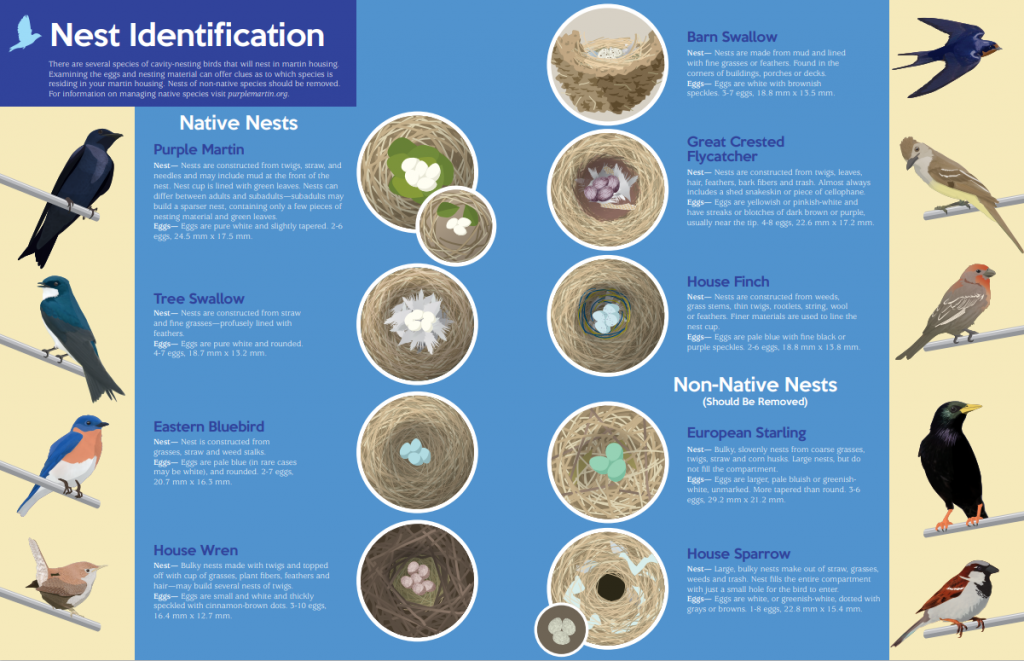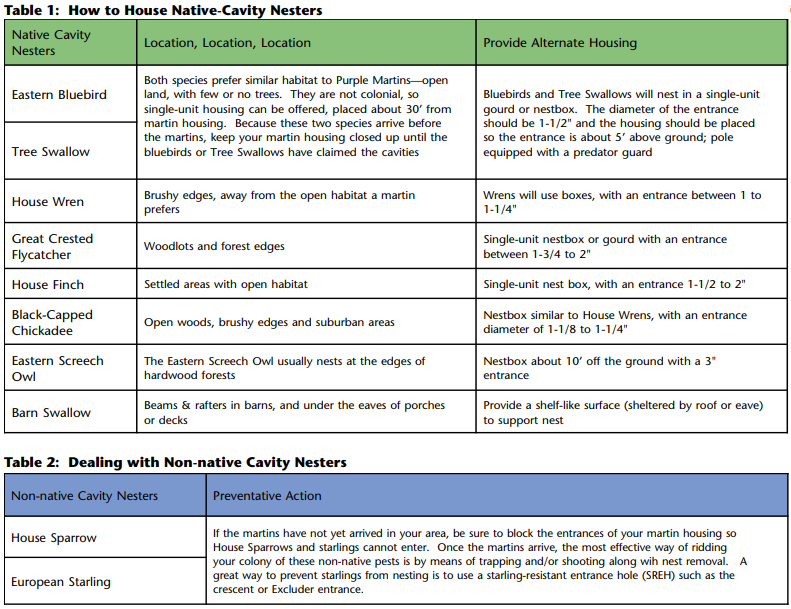Your houses and gourds are set up, Purple Martins have returned, but wait! Are non-Purple Martins taking up residence at your colonies?!
Several other species of cavity-nesting birds will also nest in martin housing. The task of identifying a nest can be challenging, especially if the tenant of a mystery nest is not observed entering or leaving the cavity. Not to worry, we are here to help. Below are descriptions and photos of some common cavity-nesting birds, their nests, and eggs.

Purple Martin
We know the Purple Martin well, but here is a refresher. Purple Martins build their nests out of small twigs, straw, bark, and mud; and line the nest bowl with green leaves. They build a flat nest, only about 1 to 3 inches high and some nests feature a mud dam, or lip, at the front of the nest. Adult and subadult nests can vary. Subadults, the less experienced nest builders, will generally have sparser nests that may only contain a few pieces of nesting material and green leaves. Purple Martin eggs are pure white and measure about 24.5 x 17.5mm.
Tree Swallows
Tree Swallows build nests out of straw and fine grasses, lining the cup with feathers. Their eggs are pure white and measure about 18.7 x 13.2mm.
Eastern Bluebird
Eastern Bluebirds build their nests out of fine grasses, straw, and wheat stalks. The eggs are almost always pale blue (5% of bluebirds lay white eggs, a genetic trait) and measure 20.7 x 16.3 mm.
House Wren
House Wrens build bulky nests out of twigs, usually topped off with a cup of grasses, plant fibers, feathers, and hair. Male House Wrens build several ‘dummy’ nests entirely of twigs, and the female chooses one to complete with the cup of grasses. The eggs are white but thickly speckled with cinnamon-brown dots and measure 16.4 x12.7 mm.
Barn Swallows
While Barn Swallows are not cavity nesters, they are often confused with Purple Martins. Barn Swallows will nest in barns, under decks, porches, bridges, and docks. Nests are built out of mud and lined with feathers and grass. The eggs are white, with brownish speckles and measure 18.8 x 13.5 mm.
House Sparrow
House Sparrows build bulky nests from straw, weeds, grasses, and trash. The nest is lined with feathers, hair, and string. House Sparrow nests will fill the entire compartment, leaving only a circular tunnel where they enter. You will oftentimes see the nests spill out of the entrance. Eggs are white or greenish white, dotted with grays or brown, and measure 22.8 x 15.4mm.
European Starling
Starlings, like House Sparrows, build bulky, slovenly nests of coarse grasses, weed stems, straw, twigs, corn husks, cloth, and feathers. These eggs are similar in color to robin eggs, but larger, pale blue or green, unmarked, and measure about 29.2 x 21.2mm.
What to do if you find another species nest in your house or gourd?
If the martins have not yet arrived in your area, be sure to block the entrances of your martin housing so House Sparrows and starlings cannot enter. Once the martins arrive, the most effective way of ridding your colony of these non-native pests is by means of trapping and/or shooting along with nest removal. A great way to prevent starlings from nesting is to use a starling-resistant entrance hole (SREH) such as the crescent or Excluder entrance.

Management of competing cavity-nesting species is a critical element in establishing a martin colony, and ensuring its continued well-being. Cavity-nesting competition, whether from non-native or native bird species, is best avoided by taking preventative action. By positively identifying the birds that take interest in martin housing, you can determine which course of action to follow.
With non-native birds, quick identification and eviction can prevent needless damage to your martin colony. In the case of native competition, providing alternative housing early on can help facilitate a quick and easy shift of interest (from martin housing to another location), allowing you to enjoy the presence of several cavity-nesting birds in your yard.
We hope this blog post has been helpful! If you have any questions, please leave a comment and we will respond ASAP. For more resources, check out the links below for downloadable PDFs and links to our Shop.
Resources:
Shop:
